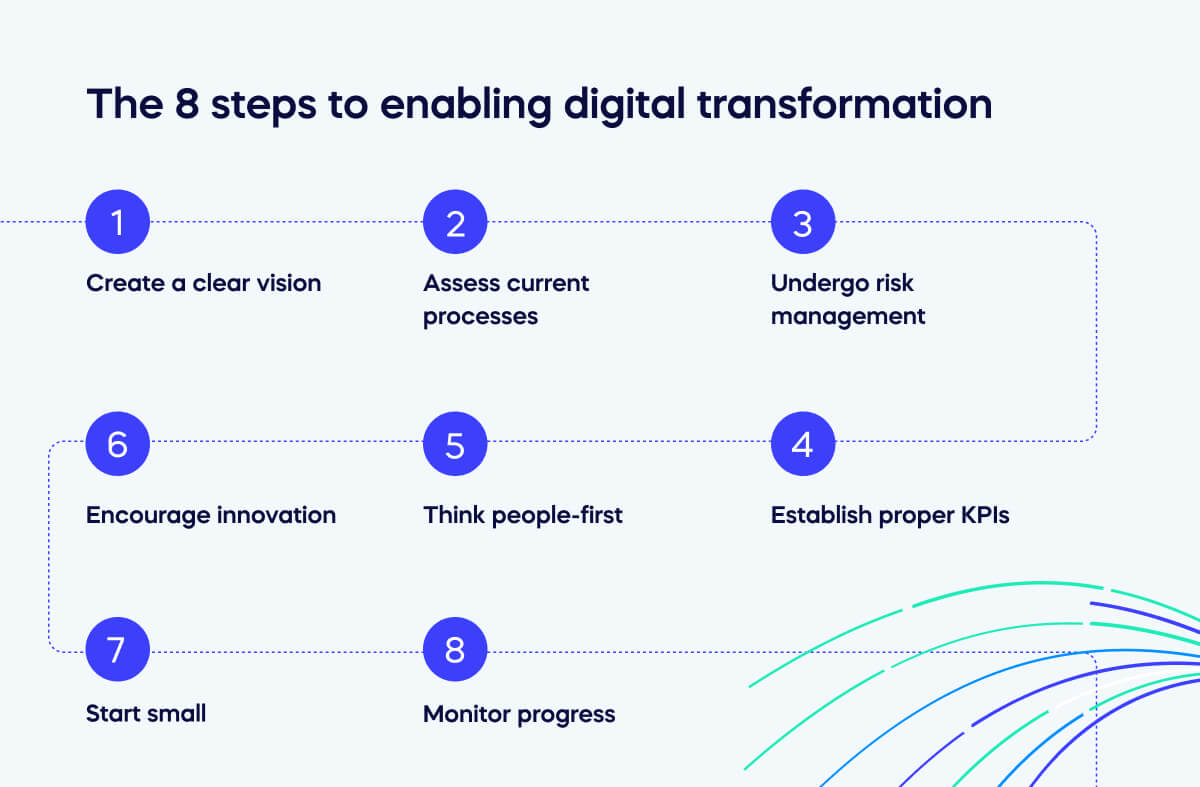Digital transformation is the process of using technology to create new ways of doing business. The concept can comprise changing existing systems or building new ones.
Company culture, business processes, and customer experience can all be upgraded by digital transformation.
Digital transformation is a continuous process of adapting, changing, and improving over time, so it’s important for everyone within the organization to be on board.
By implementing digital transformation, businesses can keep up with changing demands within their market and the business world at large.
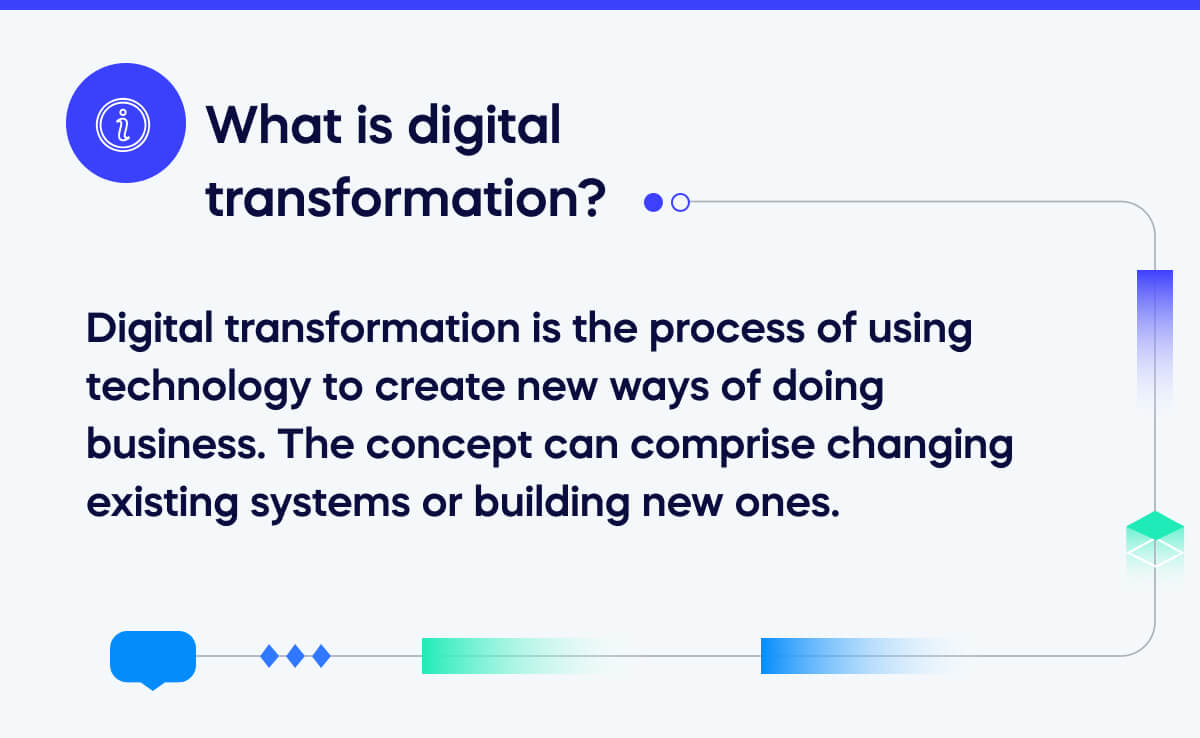
How does digital transformation work?
No two businesses are identical, so digital transformation processes are not one-size-fits-all. A company’s approach depends on its needs, goals, and structure.
Many examples of enterprises have undergone successful digital transformation, but here are some ways such a change can be carried out within specific organizations.
- A government agency may digitize its records and implement an online platform to streamline citizen services such as paying taxes or renewing licenses.
- An educational company may shift traditional classroom learning to online platforms, increasing their audience reach and providing flexible learning opportunities.
- A furniture store may create virtual showrooms with 360-degree views of products or online design tools to help customers visualize and plan their interior spaces.
- A glasses company may allow customers to try on their products by letting them upload a photo of themselves to the website.
- An e-commerce store may use AI algorithms to analyze customer behavior and preferences, subsequently offering personalized recommendations based on previous purchases and browsing history.
Why is digital transformation important?
Companies are increasingly spending on digital transformation processes, with Gartner forecasting that worldwide IT spending will total $4.7 trillion in 2023.
But why is digital transformation seen as so important?
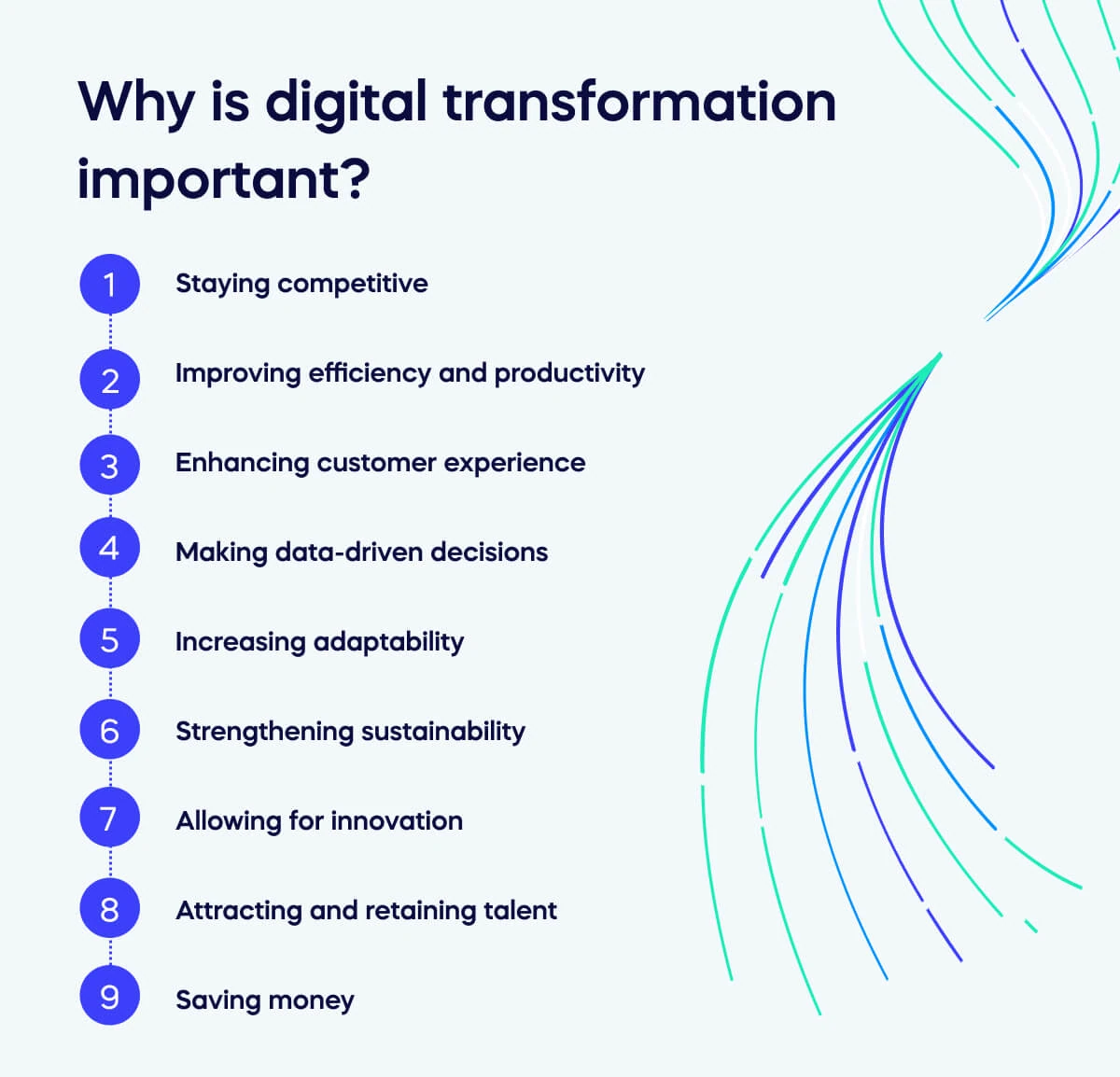
Staying competitive – Businesses that do not embrace digital transformation risk falling behind their competitors, who have upgraded their tools and processes to become more efficient and effective.
Improving efficiency and productivity – Digital transformation streamlines processes, automates tasks, improves data management, frees time for employees to focus on other business areas, and improves productivity.
Enhancing customer experience – Companies can offer online services, personalized interactions, quick responses to queries, and a more seamless experience, which means digital transformation is vital for customer experience.
Making data-driven decisions – Organisations can collect and analyze digital transformation data at scale, using it to understand customer behavior and preferences. They can then make informed decisions to create products and services that better meet customer needs.
Increasing adaptability – Digital transformation allows companies to keep up with changing market conditions and customer demands. They have enhanced capabilities for taking a consistently responsive and flexible approach.
Strengthening sustainability – With digitized processes in place, companies can reduce their energy consumption and paper waste, allowing them to take an environmentally friendly and sustainable approach to their business.
Allowing for innovation – By implementing digital transformation processes, companies can explore new business models, develop new products or services, or enter new markets.
Attracting and retaining talent – Creating a technologically advanced company means that younger generations entering the workforce are more likely to apply. Companies with digital transformation strategies are likely to attract and retain top talent.
Saving money – Digital processes reduce the need for physical resources, manual labor, and paperwork, significantly reducing costs in the long run.
Types of digital transformation
There are multiple types of digital transformation:
Process transformation
A significant change or advancement is made to the implementation, flow, design, or activities involved in a particular process. This type of digital transformation focuses on achieving specific goals, such as improved efficiency through technological improvement.
Process transformation may be triggered by changes in internal or external environments or a lack of effectiveness with the current processes. It aims to support company goals and use technology to reduce costs.
Business model transformation
A broader approach comprises changes in how a product or service is taken to market. Instead of focusing on making incremental improvements or incorporating new technology, this type of digital transformation involves radically rethinking and restructuring the entire business model.
Business model transformation can become necessary due to changing market conditions, disruptive technologies, a shift in customer preferences, or other external factors that can impact the company’s long-term viability. The goal is to ensure an organization remains relevant and successful.
Domain transformation
This type of transformation is not as widely discussed, but it can be hugely successful. Domain transformation is when a business wants to enter a new market and diversify its portfolio.
New competitors or technologies may make it difficult to continue with or rely on the current business plan, so domain transformation helps to keep a company active and successful.
Cultural or organizational transformation
Management focuses on the people who power the company when cultural or organizational transformation is underway. A shift occurs in terms of either the behaviors and attitudes of employees to assist with achieving key goals or a restructuring of the organization to promote transparency, inclusivity, community, and collaboration.
Cultural or organizational transformation generally enables employees to become more open to digital adoption, as they will recognize the benefit of working for a digital-first business and become digital transformation enablers.
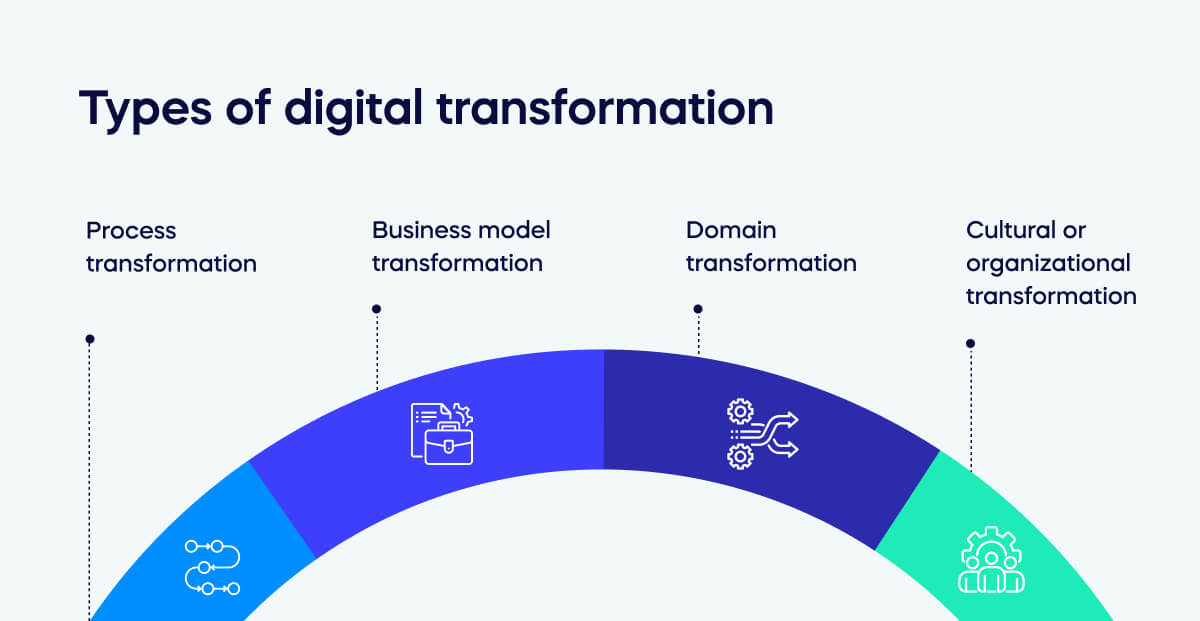
Digital transformation by industry type
The implementation of digital business transformation can be different depending on the industry. Here’s how some major industries are dealing with digital transformation in 2023.
Banking
Digital transformation in banking can take place with measures such as omnichannel banking, personalization, data-driven decision-making, and collaboration with FinTech. The change has been slower than with other industries due to security concerns and the deep integration of systems.
Professional services
Digital transformation in professional services is being seen in sectors such as consultancies, tax companies, auditing organizations, and those offering financial advice. These businesses benefit from edge computing, quantum computing, smart contracts, virtual presences, and blockchain.
Insurance
Digital transformation in the insurance industry is relatively new. Organizations use data analytics to better sense customer needs and identify growth opportunities. The industry is under pressure to digitize to remain competitive in the sector.
Healthcare
Digital transformation in the healthcare industry has resulted in huge changes in the sector. AI and VR-based technologies have improved the customer experience and processes within organizations. Healthcare services are becoming more personalized as digital health data becomes increasingly available.
7 drivers for digital transformation in 2023
When businesses choose to implement digital transformation, they are motivated to do so. While increased profits are at the crux of any operation, this digital change has a business-specific driver.
Here are the 7 drivers for digital transformation in 2023.
Creating new business models
Companies want to stay ahead of the digital curve. By developing new digital transformation models, they can develop cutting-edge products, services, or delivery channels to keep them competitive – both with other companies and with their existing product lines and offerings. For example, 2023 has seen the rise of freemium, on-demand, and subscription models.
Enhancing customer experiences
Businesses must keep up with the convenience customers can access when shopping online, streaming videos, banking from their smartphones, etc. Developing adaptive AI for personalized recommendations and AI trust, risk, and security management can help enhance customer experiences.
Modernizing IT infrastructure
Legacy IT infrastructure can be a critical part of daily operations in several organizations, but keeping these systems in place prevents the company from achieving improved growth and scalability. It also won’t work well with other methods, and getting support will be difficult.
As a result, modern systems such as the Internet of Things (objects connected to the Internet that can communicate with each other and centralized systems), cloud-native application development, and Business Intelligence (BI) for analytical reporting will help greatly with business growth.
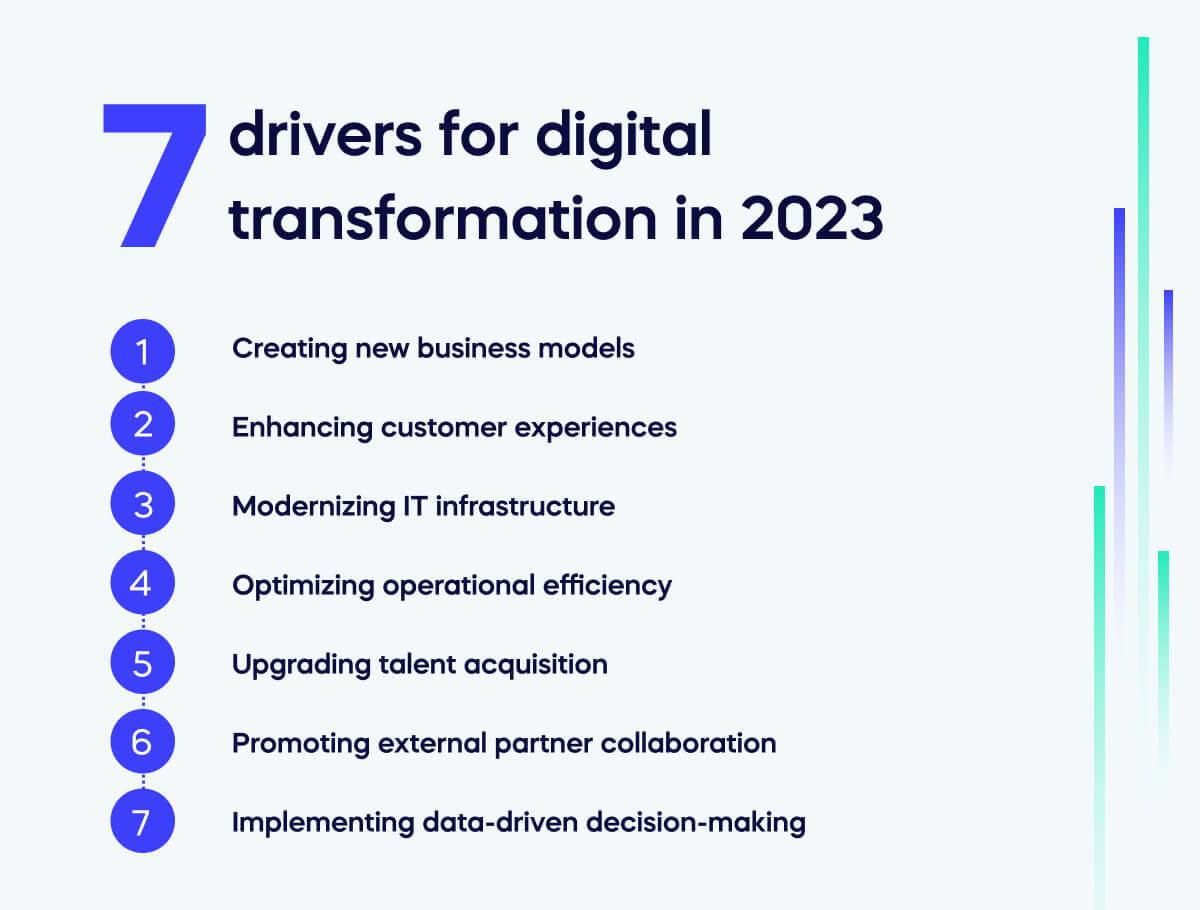
Optimizing operational efficiency
Existing business procedures for internal and external interactions may involve time-consuming manual steps and complex authorization protocols. They are also subject to human error. By digitizing operations, businesses can facilitate new applications, utilize API services, and benefit from automated systems to bolster their operations and maximize efficiency.
Upgrading talent acquisition
Existing employees may not be current on the latest systems or technologies. Therefore, digital transformation can encompass training employees, getting them certified, and providing educational seminars.
Another way businesses can plug the knowledge gap is by taking on new hires who are up to date with the latest innovations in the industry. If the company has upgraded with digital transformation processes, it will be more likely to attract and retain new employees.
Promoting external partner collaboration
Digitizing company processes assists with the promotion of strong integration with stakeholders such as marketing and delivery channels, suppliers, vendors, and partners. There is still some hesitation when sharing data with third parties, but the benefits of external collaboration are clear – the construction of new business models, improved products or services, and better delivery channels.
Implementing data-driven decision-making
Decision-making is quicker and more accurate if data drive it. Digitizing company operations makes data accessible so key stakeholders can trace operation development, report on previous outcomes, and anticipate future events. Verifiable facts can be used to create measurable metrics and monitor their progression, resulting in more effective operations.
3 reasons why digital transformation fails
People
Getting the people in a company behind the digital transformation processes is vital. Stakeholders will be accustomed to existing ways of working, so they will resist change. Figuring out how to manage organizational change is important, as reframing the narrative so that employees are taken on the journey with management will help them to feel excited about it instead of overwhelmed by culture shock.
Poor communication
It’s advisable to keep everyone informed as the digital transformation journey progresses. Simply announcing a new initiative will not be enough for it to succeed. Instead, leadership needs to take the time to communicate how and why the changes are happening. Positive actions can include sharing a demo, giving employees an early release of a product that is being transformed, and requesting feedback so that they feel part of the process.
Lack of measurement
As digital transformation is a process, setting goals will help keep it on track and ensure that key targets are met. Standard KPIs may already be in place, but these may need to be reset if the method of doing business is changing. There must be a clear reason for the transformation and a vision of how the business will operate afterward.
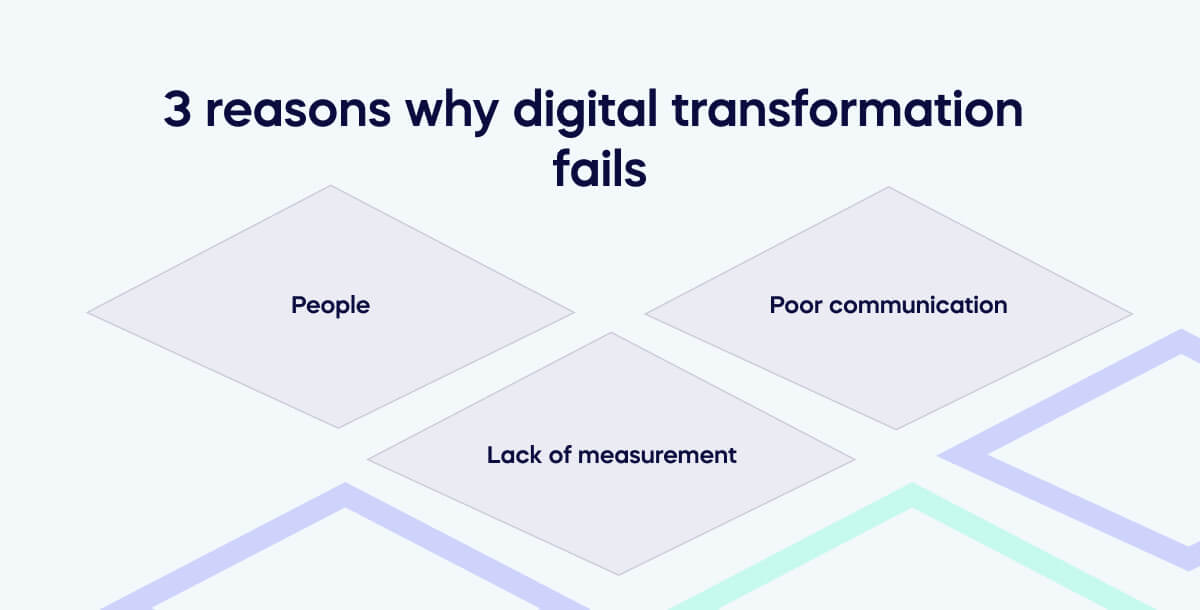
2023 Digital Transformation trends to watch
New digital transformation technologies are the main focus in 2023, with Matthew Higham from Microsoft UK revealing that ‘words like cloud, digital and AI have all become buzzwords, and everybody latches onto them…more and more people…will own the digital agenda as part of their normal traditional role and become much more technology-focused.’
With that in mind, here are several important trends set to impact businesses in the coming months.
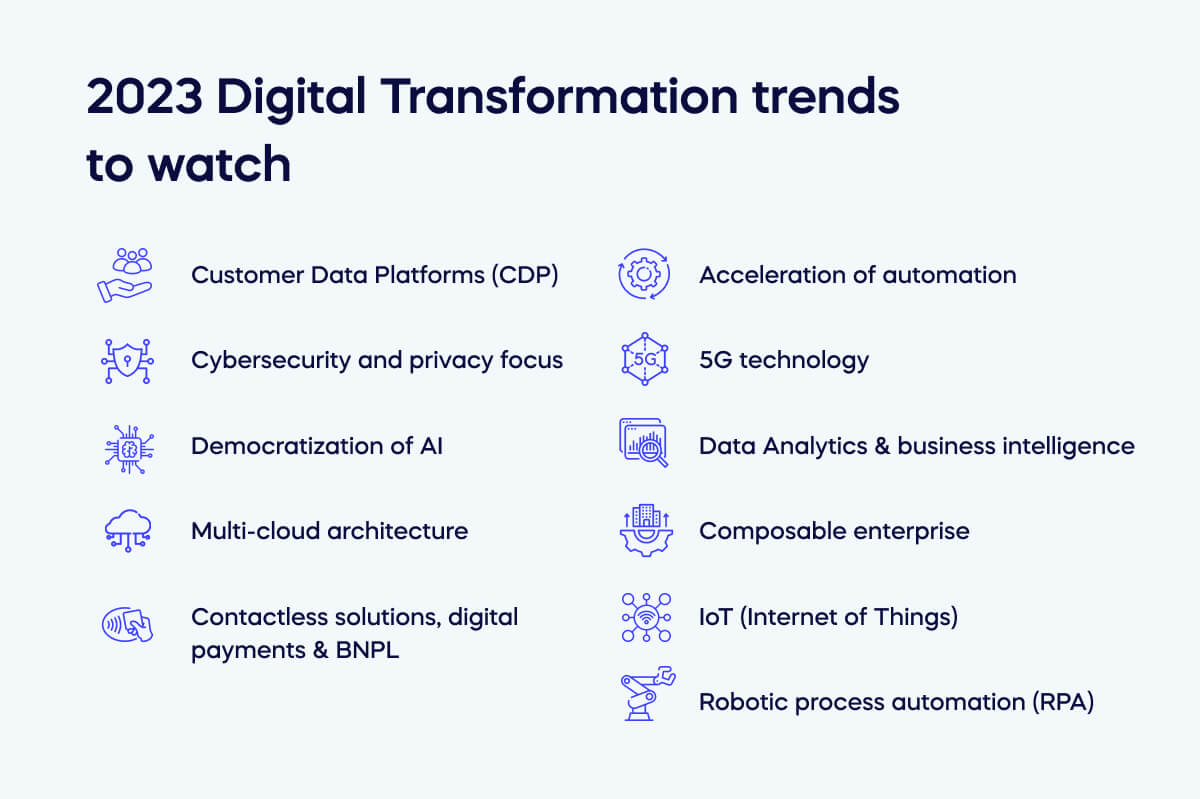
Customer Data Platforms (CDP)
Customer Data Platforms, or CDPs, are gaining popularity, especially in marketing. They are a powerful tool for businesses, comprising a centralized platform for collecting and managing customer data. Employees can quickly analyze business performance and make data-led decisions to improve areas that aren’t doing as well.
Cybersecurity and privacy focus
The rollout of regulations such as GDPR and CCPA has clarified that there is an increased emphasis on protecting user data. With technology providing access to higher levels of customer information at a glance, security and privacy risks must be duly considered in tandem. Gartner predicts that fines related to mismanagement of data subject rights will exceed $1 billion by 2026, so it’s becoming more important to keep cybersecurity and privacy at the forefront.
Democratization of AI
AI is becoming more accessible, understandable, and usable by various individuals and organizations. As a result, AI adoption in the workplace is increasing in popularity as it can be adapted by people with varying levels of technical expertise for their own professional needs and purposes.
2023 research from Gartner reveals that 63F of marketing leaders plan to invest in Generative AI in the next 24 months.
Multi-cloud architecture
Businesses increasingly recognize the benefit of using services from a range of cloud providers to meet their computing needs. Organizational benefits of multi-cloud architecture include optimized resources, reduced costs, and sped-up application development.
Spreading this resource across multiple providers also ensures that the risk of potential outages or service disruption is mitigated, and the latest technologies can be experimented with when released in the competitive landscape of cloud computing.
Contactless solutions, digital payments & BNPL
Payment and transaction methods continue to improve with technological advancement, providing greater simplicity and flexibility for the customer. The pandemic played a major part in speeding up this shift, as organizations were forced to rethink how they interact with customers.
As a result, contactless solutions such as mobile wallets, wearable devices, and contactless cards have been on the rise, as well as the option to pay bills via online platforms, mobile apps, QR codes, and bank-specific apps. BNPL, short for Buy Now, Pay Later, has allowed customers to pay for their purchases in installments with interest-free periods, and payment plans are becoming more prevalent.
Acceleration of automation
There is a rapid increase and advancement in automated technologies being used across various industries and sectors. Organizations can benefit from improved efficiency, accuracy, and productivity by enabling specific tasks or processes to be automated with minimal human intervention. Robotic Process Automation, or RPA, is an implementation of automation, as repetitive and rule-based tasks can be automated using software robots.
5G technology
5G technology is quickly becoming the standard for communication, offering faster speeds and more reliable connections. Benefits for organizations include faster data transfers, smoother video conferencing, and quicker access to cloud-based applications. Ultimately, this technology makes businesses more productive and responsive in real-time.
Data Analytics & business intelligence
Companies can extract meaningful insights, patterns, and trends by examining and interpreting information with data analytics. They can use business intelligence (BI) to visualize data and support decision-making and strategic planning. Companies can make more effective decisions based on understanding customer behavior h as a result.
Composable enterprise
Companies increasingly develop their digital capabilities by using existing apps and no-code solutions instead of building them from scratch each time. Hyper-specialized companies using this approach construct composable enterprises – a new way of developing and building company architecture.
IoT (Internet of Things)
The IOT is a network of interconnected physical devices, vehicles, buildings, and other objects embedded with sensors, software, and connectivity capabilities. These objects can collect and exchange data over the internet. They are becoming increasingly popular for many business purposes, including data collection, predictive maintenance, supply chain optimization, and enhanced customer experiences.
Robotic process automation (RPA)
Robots are spreading into analytics and decision-making, and RPA’s role in digital transformation includes accelerating tasks while ensuring greater accuracy and operational efficiency. Overall, it frees up human resources for higher-level jobs.
The 8 steps to enabling digital transformation
Follow these steps if you want your digital transformation strategy to succeed.
Create a clear vision
Set out a clear definition of why you want to undergo a digital transformation process. For example, you may want to streamline operations, improve customer experience, or enter new markets. Whatever your goals are, ensure there is a clear vision for where the business is going.
Assess current processes
Carry out a comprehensive assessment of current business processes, technologies, and organizational culture to identify any pain points, bottlenecks, and opportunities for improvement.
Undergo risk management
Identify potential risks and challenges, including security vulnerabilities, data privacy concerns, or employee resistance. Take the time to develop mitigation strategies to address these points of possible friction.
Establish proper KPIs
Define measurable KPIs which will help you to track the success of your digital transformation efforts. For example, you may develop cost savings, revenue growth, or customer engagement metrics. Ensure reporting systems are set up ahead of time so that the process can be kept on track.
Think people-first
Consider how the digital transformation process will impact customers and employees. Ensure that customers are kept at the epicenter of any transformation in response to drastic changes in the market.
Develop processes that ensure customer satisfaction is front and center. Keep all stakeholders informed about the progress and benefits of digital transformation. Address concerns, gather feedback, and keep them involved in the process to mitigate resistance.
Encourage innovation
To successfully achieve digital transformation, being agile is essential. It begins by creating a business environment that fosters experimentation and encourages innovative thinking to take root and thrive. Encourage teams to work across departments so that new business processes become holistic and everyone understands how others contribute to business operations.
Start small
Test out new processes by launching small pilot projects to test new business operations. Keeping the projects manageable will make it easier to identify challenges and refine your approach so that roadblocks can be tackled. Once the pilot succeeds, successful initiatives can be scaled up across the organization.
Monitor progress
Constantly check and monitor the progress of your digital transformation program against objectives to ensure it is on track. Analyze outcomes and adjust strategies that aren’t performing as expected to keep the process on track.
